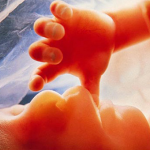“Some time in the not too distant future, there will be formal recognition of same- sex couples, and the sky will not fall in, and we will not be destroyed like Sodom and Gomorrah, and life will continue.”
One would assume that such an assertion describing the actions of persons, the prediction of consequences and the intervention of God would have to be grounded in some kind of authoritative source. From the content of the assertion we know that it is not the authority of the Church. Rather, what gives Ms Plibersek and others the conviction to make such claims is the notion of a “higher” or more “enlightened” perception of reality than that which traditional wisdom and Divine Revelation offer. According to this view, “we should recognise and value human kindness and constancy; we should seek to increase the sum total of happiness, not shrink from it with proscription and prejudice2.” I do not think we need to disagree with this proposal per se. However, in the context of the debate, Ms Plibersek is characterising two possible responses to the question of civil unions and in doing so is greatly over-simplifying the issues involved. Faced with the question, Plibersek suggests that one can agree or disagree. Those who agree are “increasing the sum total of happiness” and are valuing the things that really matter- kindness and constancy. Those who disagree must have no other motive than plain “prejudice”. Such a presentation of options is, of course, unfair, but the attitude is actually remarkably prevalent among those whom one would usually consider to be well educated, professional and impartial. And it always seems to rear its head in contentious ethical debates in which the Church stands accused and often gets a good battering.

Tanya Plibersek
The issue of civil unions is particularly important in the context of such accusations. In presenting the Church teaching on the inadmissibility of same-sex unions there are several significant challenges. First, the subject itself is sensitive. Homosexuality is a difficult and real condition for a large number of people, including many Christians. Too often, in the face of such sensitivity people have fallen to either of Ms Plibersek’s extremes (neither of which is legitimate): either open support of the homosexual lifestyle or, on the other hand, a condemnation of the person. The Church teaches that the particular inclination of the homosexual person is not a sin (the origins of the condition remain debated but many psychologists suggest the effects of arrested development, trauma and parent-child relationships) but that it is “a more or less strong tendency ordered toward an intrinsic moral evil, and thus the inclination itself must be seen as an objective disorder3”. Given this disorder, the homosexual person must be treated with “respect, compassion, and sensitivity4”. But it is a false mercy to condone homosexual acts and an insult to the person to assume that he or she does not possess the same free will that characterises the human person and gives every human person his intrinsic dignity. The Church calls the person with homosexual inclinations to chastity just as every Christian is called to chastity. But the Church also calls for pastoral programs to assist those with same-sex attractions by supporting them in the abandonment of homosexual activity through spiritual support and by the teaching of the truth: “only what is true can ultimately be pastoral. The neglect of the Church’s position prevents homosexual men and women from receiving the care they need and deserve5.” It is important to understand that a legitimate concern for the homosexual person does not equate with an approval of homosexual acts, as many have mistakenly done, in the name of enlightened “tolerance” or “acceptance”. Note the difference between the “Catholic” movement called Acceptance and the Courage organisation. The former announces on the web-site of the organisation that,
“it is OK to be Gay and Catholic. We are born gay and lesbian. We are proud to be gay and lesbian.6”
The mission of Acceptance is a
“striving for full recognition and acceptance of homosexual, bisexual and transgender Catholics enabling them to celebrate their God-given sexuality and to receive the Sacraments as full members of the Catholic Church.7”
The group takes part in the Mardi Gras every year and gathers for Mass every Friday night at St Joseph’s Catholic Church Newtown. I noticed that the post I placed on the message board of the site explaining what Courage does and how it helps has been removed.
Courage, on the other hand describes its foundation referring to the vision of founder, Terence Cardinal Cook thus:
“He knew that the individual dealing with same-sex attractions truly needed to experience the freedom of interior chastity and in that freedom find the steps necessary to living a fully Christian life in communion with God and others. He was concerned that many would not find this path and would be constantly trying to get their needs met in ways that ultimately do not satisfy the desires of the heart.8”
Courage has the full endorsement of the Holy See, the first of its Five Goals being “[The living of] chaste lives in accordance with the Roman Catholic Church’s teaching on homosexuality9.”
If the response to the difficulties in outreach to homosexual persons is like that of Acceptance, one could not help but support the socio-political gay “movement” which presents itself as a civil rights movement. And this brings me to my second concern.
Facing the question of civil unions, one must also navigate the terrain of agendas. The Church is “concerned about the many who are not represented by the pro- homosexual movement and about those who may have been tempted to believe its deceitful propaganda10”. The protest for equal rights and acceptance formally began with a three-day riot after a police raid on a gay bar in New York in 1969 and quickly developed into widespread activism. But although inadequate assistance or persecution may have exacerbated the sufferings of homosexual persons at that time, the grounds for claiming equal rights are fallacious. “The human person, made in the image and likeness of God, can hardly be adequately described by a reductionist reference to his or her sexual orientation11.” Sexual orientation is not an inherent trait like race and cannot be the grounds for claims to non-discrimination in the same way. Race can be a characteristic of a minority group because it is inherent in the person, not the person’s behaviour. But homosexual persons can only make themselves a minority by behaviour12. It is a sorry state of affairs that, acceding to the pressure of activism and the shifting moral mores of the time, the American Psychiatric Association in 1973, without the necessary research or reflection, abandoned any categorisation of homosexual orientation in the Diagnostic and Statistical Manual III. They have been, ever since, justifying this move through less than professional research, and the disappointing thing is that they are able to use their respected name and the pretext of science to do so. This must be classified a grave failure in a duty of care for “those whose suffering can only be intensified by error and lightened by truth13”. There is a genuine political agenda involved in the push for civil unions. One need only read the policies of certain political parties on homosexuality (such as the Greens and Democrats) to ascertain this reality. And so the person who engages in the civil-unions debate must be aware that not only is he broaching a sensitive subject but one that is ideologically driven.
The final difficulty to be anticipated in this debate is the issue of non-discrimination. The concept of ‘just’ and ‘unjust’ discrimination needs to be dealt with at length in a subsequent article. Suffice to say here that the Plibersek-like attitude of our times has managed to enshrine human rights as the highest authority in any argument. Unfortunately, in the absence of reference to objective truth, these “rights” often come to mean whatever the majority is doing, or whatever somebody on his own authority thinks is a nice idea. There is much talk of rights but little reference to duties14. The Human Rights and Equal Opportunity Commission recently published their Same Sex: Same Entitlements National Inquiry into Discrimination against People in Same- Sex Relationships: Financial and Work- Related Entitlements and Benefits which recommends changes to 58 pieces of Australian Federal legislation so that people living in same-sex relationships can receive the same benefits as all other de facto or married couples and families in their lives together. The government has promised to enforce these recommendations. There will be no ‘conscience vote’ on this issue since it is now ALP policy. When the principle of non- discrimination is enshrined in law, injustices abound. “The principles of respect and non- discrimination cannot be invoked to support legal recognition of homosexual unions. Differentiating between persons or refusing social recognition or benefits is unacceptable only when it is contrary to justice. The denial of the social and legal status of marriage to forms of cohabitation that are not and cannot be marital is not opposed to justice; on the contrary, justice requires it15.” This point seems lost entirely on many civil authorities today. Rather than make reasoned reference to the common good, it is all too easy, in the name of tolerance, to dismiss any opposition to a liberal agenda with the politically-charged accusation of discrimination. Indeed, with the weight of legislation and public opinion behind them, supporters of societal recognition of same- sex unions can claim that anyone who opposes such laws is guilty of homophobia (or, as one spokesperson put it in the HREOC document, “heterosexism”). This is a convenient way to dismiss opponents, even if they use the most rational and reasonable arguments.
In light of these challenges and in order to comprehensively address the question of civil unions between same-sex couples one needs to understand the nature of marriage as an institution and the way in which such “non-discriminatory” legislation may threaten its already weakened position. Furthermore, to understand the reasons and the grounds people have for endorsing same-sex unions, it is necessary to have a look at how marriage has historically been treated in civil law and the factors that have led to the confusion we have today. In this way, we will be in a better position to engage the issue.
1 House of Representatives Official Hansard, June 17 2004, Marriage Legislation Amendment Bill 2004, p. 30735, http://www.aph.gov.au/hansard/reps/dailys/ dr170604.pdf
2 ibid, p. 30793.
3 Letter to the Bishops of the Catholic Church on the Pastoral Care of Homosexual Persons, 5.
4 Catechism of the Catholic Church, 2358.
5 Letter to the Bishops of the Catholic Church on the Pastoral Care of Homosexual Persons, 17.
6 http://www.gaycatholic.com.au/
7 ibid.
8 http://www.couragerc.net/TheCourageApostolate. html
9 ibid.
10 Ibid, 9.
11 Ibid, 16.
12 Harvey, John, F. (1996). The Truth about Homosexuality: The Cry of the Faithful, Ignatius.
13 Letter to the Bishops of the Catholic Church on the Pastoral Care of Homosexual Persons, 18.
14 Harvey, John, F. (1996). The Truth about Homosexuality: The Cry of the Faithful, Ignatius, p. 192.
15 Congregation for the Doctrine of the Faith, Considerations regarding proposals to give legal recognition to unions between homosexual persons, 2003, 8.










